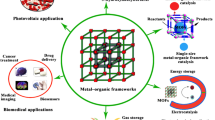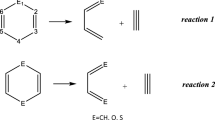Abstract
The ability of cyclodextrins to form inclusion complexes with hydrophobic species in aqueous solution makes them well-suited to the development of molecular reactors, to be used as miniature reaction vessels in order to control the outcomes of chemical transformations at the molecular level. In this manner, reaction rates can be increased and products may be obtained that are different to those normally accessible from reactions in free solution. Examples used to illustrate these effects include: the application of cyclodextrins to control the regioselectivity of bromination of aromatic substrates with pyridinium dichlorobromate: the use of a metallocyclodextrin to increase the rate of hydrolysis of a phosphate triester by almost five orders of magnitude; the development of modified cyclodextrins to increase the rates and reverse the regioselectivity of nitrile oxide cycloadditions ; and the use of a cyclodextrin dimer to change the ratio of formation of indigoid dyes by a factor of more than 3500.
Similar content being viewed by others
References
C.J. Easton and S.F. Lincoln: Modified Cyclodextrins.Scaffolds and Templates for Supramolecular Chemistry, Imperial College Press, London (1999).
R. Breslow and P. Campbell: J. Am. Chem. Soc. 91, 3085 (1969).
R. Breslow and P. Campbell: Bioorg. Chem. 1, 140 (1971).
R. Breslow, H. Kohn, and B. Siegel: Tetrahedron Lett. 1645 (1976).
R. Chênevert and G. Ampleman: Can. J. Chem. 65, 307 (1987).
M. Komiyama and H. Hirai: J. Am. Chem. Soc. 106, 174 (1984).
P.G. Dumanski, C.J. Easton, S.F. Lincoln, and J.S. Simpson: Aust. J. Chem. 56, 1107 (2003).
R.L. VanEtten, J.F. Sebastian, G.A. Clowes, and M.L. Bender: J. Am. Chem. Soc. 89, 3242 (1967).
R.L. VanEtten, G.A. Clowes, J.F. Sebastian, and M.L. Bender: J. Am. Chem. Soc. 89, 3253 (1967).
R. Breslow and S.D. Dong: Chem. Rev. 98, 1997 (1998).
E. Rizzarelli and G. Vecchio: Coord. Chem. Rev. 188, 343 (1999).
L. Barr, C.J. Easton, K. Lee, S.F. Lincoln, and J.S. Simpson: Tetrahedron Lett. 43, 7797 (2002).
(a)D.C. Rideout and R. Breslow: J. Am. Chem. Soc. 102, 7816 (1980); (b) D.D. Sternbach and D.M. Rossana: J. Am. Chem. Soc. 104, 5853 (1982); (c) H.-J. Schneider and N.K. Sangwan: J. Chem. Soc., Chem. Commun. 1787 (1986); (d) H.-J. Schneider and N.K. Sangwan: Angew. Chem., Int. Ed. Engl. 26, 896 (1987); (e) N.K. Sangwan and H.-J. Schneider: J. Chem. Soc., Perkin Trans. 2, 1223 (1989); (f) D.L. Wernick, A. Yazbek, and J. Levy: J. Chem. Soc., Chem. Commun. 956 (1990); (g) I. Hunt and C.D. Johnson: J. Chem. Soc., Perkin Trans. 2, 1051 (1991).
For examples, see (a) T. Tamaki and T. Kokubu: T. J. Incl. Phenom. 2, 815 (1984); (b) T. Tamaki, T. Kokubu, and K. Ichimura: Tetrahedron 43, 1485 (1987); (c) J.N. Moorthy, K. Venkatesan, and R.G. Weiss: J. Org. Chem. 57, 3292 (1992); (d) W. Herrmann, S. Wehrle, and G. Wenz: Chem. Commun. 1709 (1997); (e) T. Nozaki, M. Maeda, Y. Maeda, and H. Kitano: J. Chem. Soc., Perkin Trans. 2, 1217 (1997); (f) M. Maa, J.-J. Aaron, and C. Lion: J. Incl. Phenom. 30, 227 (1998).
(a) A.G. Meyer, C.J. Easton, S.F. Lincoln, and G.W. Simpson: Chem. Commun. 1517 (1997); (b) A.G. Meyer, C.J. Easton, S.F. Lincoln, and G.W. Simpson: J. Org. Chem. 63, 9069 (1998).
C.J. Easton, J.B. Harper, and S.F. Lincoln: New J. Chem. 22, 1163 (1998).
J.B. Harper, C.J. Easton, and S.F. Lincoln: Tetrahedron Lett. 44, 5815 (2003).
J. Yang and R. Breslow: Angew. Chem., Int. Ed. Engl. 39, 2692 (2000).
J. Yang, B. Gabriele, S. Belvedere, Y. Huang, and R. Breslow: J. Org. Chem. 67, 5057 (2002).
C.J. Easton, C.M.M. Hughes, G.P. Savage, and G.W. Simpson: Adv. Heterocycl. Chem. 60, 261 (1994).
C.A. Haskard, B.L. May, T. Kurucsev, S.F. Lincoln, and C.J. Easton: J. Chem. Soc., Faraday Trans. 93, 279 (1997).
Author information
Authors and Affiliations
Rights and permissions
About this article
Cite this article
Barr, L., Dumanski, P.G., Easton, C.J. et al. Cyclodextrin Molecular Reactors. Journal of Inclusion Phenomena 50, 19–24 (2004). https://doi.org/10.1007/s10847-004-8833-9
Issue Date:
DOI: https://doi.org/10.1007/s10847-004-8833-9




